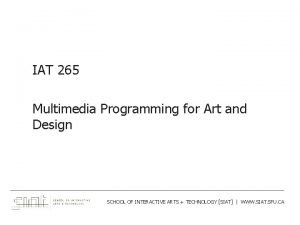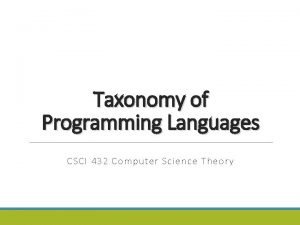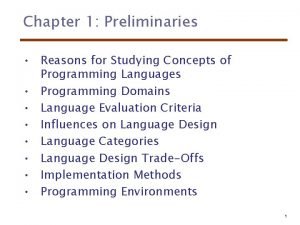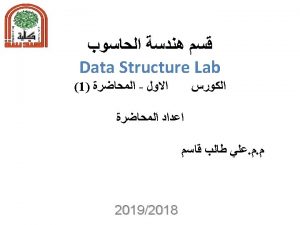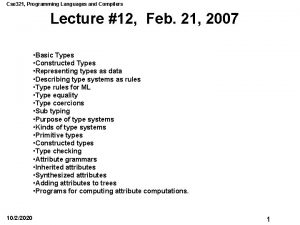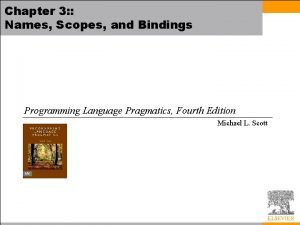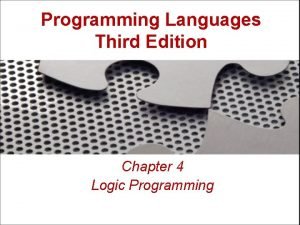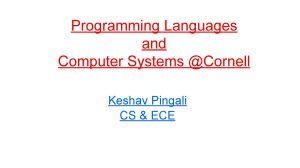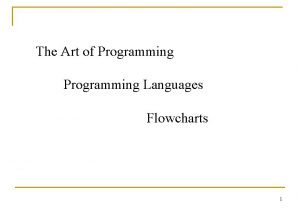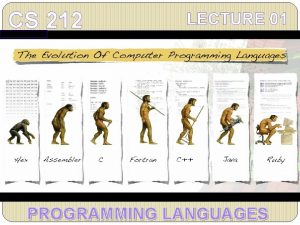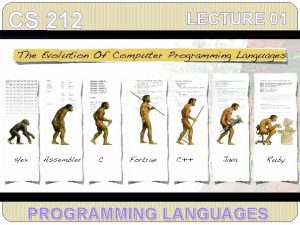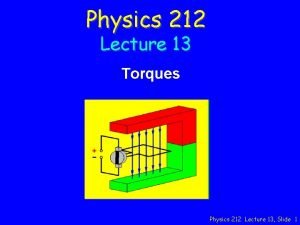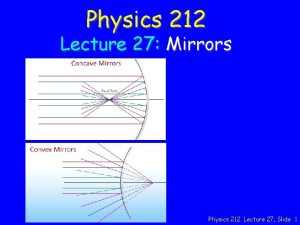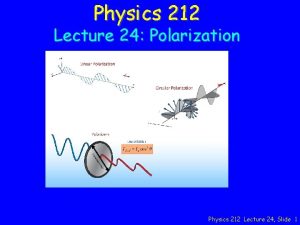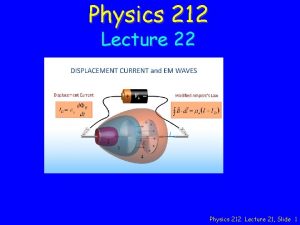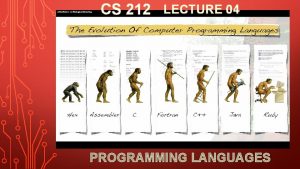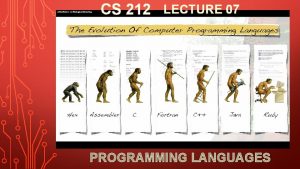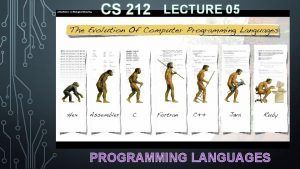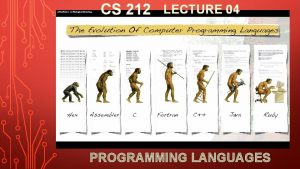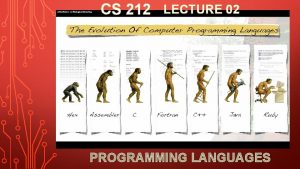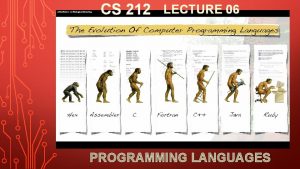CS 212 LECTURE 01 PROGRAMMING LANGUAGES CS 212



















- Slides: 19

CS 212 LECTURE 01 PROGRAMMING LANGUAGES

CS 212 PROGRAMMING LANGUAGES Instructor : Somchai Thangsathityangkul You can download lecture note at http: //kbucomsci. weebly. com/ Class Presence 10% Quiz 20% Homework 10% Midterm 20% Final 40% Total 100% 2

THE TOP PROGRAMMING LANGUAGES 2018 3

PROGRAMMING DOMAINS • Scientific applications • Large number of floating point computations • Fortran • Business applications • Produce reports, use decimal numbers and characters • COBOL • Artificial intelligence • Symbols rather than numbers manipulated • LISP • Systems programming • Need efficiency because of continuous use • C • Web Software • Electic collection of languages: markup (e. g. , XHTML), scripting (e. g. , PHP), general-purpose (e. g. , Java) 4

LANGUAGE EVALUATION CRITERIA • Readability: the ease with which programs can be read and understood • Writability: the ease with which a language can be used to create programs • Reliability: conformance to specifications (i. e. , performs to its specifications) • Cost: the ultimate total cost 5

LANGUAGE CATEGORIES • Imperative • Central features are variables, assignment statements, and iteration • Examples: C, Pascal • Functional • Main means of making computations is by applying functions to given parameters • Examples: LISP, Scheme • Logic • Rule-based (rules are specified in no particular order) • Example: Prolog • Object-oriented • Data abstraction, inheritance, late binding • Examples: Java, C++ • Markup • New; not a programming per se, but used to specify the layout of information in Web documents • Examples: XHTML, XML 6

IMPERATIVE LANGUAGES • Example: a factorial function in C int fact(int n) { int sofar = 1; while (n>0) sofar *= n-; return sofar; } 7

FUNCTIONAL LANGUAGES • Example: a factorial function in ML fun fact x = if x <= 0 then 1 else x * fact(x-1); • Example: a factorial function in Lisp (defun fact (x) (if (<= x 0) 1 (* x (fact (- x 1))))) 8

IMPLEMENTATION METHODS • Compilation • Programs are translated into machine language • Pure Interpretation • Programs are interpreted by another program known as an interpreter • Hybrid Implementation Systems • A compromise between compilers and pure interpreters 9

COMPILATION • Translate high-level program (source language) into machine code (machine language) • Slow translation, fast execution • Compilation process has several phases: • lexical analysis: converts characters in the source program into lexical units • syntax analysis: transforms lexical units into parse trees which represent the syntactic structure of program • Semantics analysis: generate intermediate code • code generation: machine code is generated 10

THE COMPILATION PROCESS 11

PURE INTERPRETATION • No translation • Easier implementation of programs (run-time errors can easily and immediately displayed) • Slower execution (10 to 100 times slower than compiled programs) • Often requires more space • Becoming rare on high-level languages • Significant comeback with some Web scripting languages (e. g. , Java. Script) 12

PURE INTERPRETATION PROCESS 13

HYBRID IMPLEMENTATION SYSTEMS • A compromise between compilers and pure interpreters • A high-level language program is translated to an intermediate language that allows easy interpretation • Faster than pure interpretation • Examples • Perl programs are partially compiled to detect errors before interpretation • Initial implementations of Java were hybrid; the intermediate form, byte code, provides portability to any machine that has a byte code interpreter and a run -time system (together, these are called Java Virtual 14

HYBRID IMPLEMENTATION PROCESS 15

JUST-IN-TIME IMPLEMENTATION SYSTEMS • Initially translate programs to an intermediate language • Then compile intermediate language into machine code • Machine code version is kept for subsequent calls • JIT systems are widely used for Java programs • . NET languages are implemented with a JIT system 16

LANGUAGES Symbol a, b. . . , Alphabet A finite, nonempty set of symbols usually denoted by String - finite sequence of symbols e. g. abba, b, bb Empty string denoted by * =set of all strings over alphabet e. g. {a, b}*} = , a, b, aa, ab{. . . , language - set of strings defined over 17

LANGUAGES Examples = { 0, 1 , 2 , 3, 4, 5, 6, 7, 8, 9 } L = { 0, 1, …, 11, … 99, …} ={a, b, c{ L={ab, ac, cabb{ ={ 1, 2, +, = } L 1 = {1+1=2} L 2 = {2+2+2+2=12} What’s about L 3={1+1= 1} ? And Examples All strings of even length ={a, b{ L= { , aa, ab, ba, bb, aaaa, . . . } All strings of a’s and b’s in equal numbers L= { , ab, ba, aabb, abab, abba, . . . } L 4 = { 1+1=3 } 18

LANGUAGES Let ={a, b, c}. The elemnets of * include Length 0 : Length 1 : a, b, c Length 2 : aa, ab, ac, ba, bb, bc, ca, cb, cc Length 3 : aaa, aab, aac, aba, abb, abc, aca, acb, acc, baa, bab, bac, …, cbc, cca, ccb, ccc … In general, if is an alphabet and L is a subset of *, then L is said to be a language over . Example { 0, 11, 001}, { , {10 , and {0, 1}* are subsets of {0, 1}*, and so they are languages over the alphabet {0, 1. { 19
 01:640:244 lecture notes - lecture 15: plat, idah, farad
01:640:244 lecture notes - lecture 15: plat, idah, farad Adam doupe cse 340
Adam doupe cse 340 Multimedia programming languages
Multimedia programming languages Lisp_q
Lisp_q Introduction to programming languages
Introduction to programming languages Vineeth kashyap
Vineeth kashyap Reasons for studying concepts of programming languages
Reasons for studying concepts of programming languages Alternative programming languages
Alternative programming languages Middle level programming languages
Middle level programming languages Programming languages
Programming languages Elsa gunter uiuc
Elsa gunter uiuc Integral data type example
Integral data type example Storage management in programming languages
Storage management in programming languages Real time programming language
Real time programming language Plc
Plc Programing languages
Programing languages Cornell programming languages
Cornell programming languages Strongly typed vs weakly typed
Strongly typed vs weakly typed Programming languages flowchart
Programming languages flowchart Language
Language


